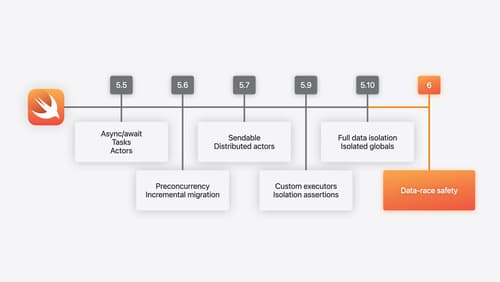what's new on swift concurrrency
Asked on 2024-08-07
1 search
What's New in Swift Concurrency
Swift has introduced several significant updates to concurrency, particularly with the release of Swift 6. Here are the key highlights:
-
Data Race Safety:
- Swift 6 introduces a new language mode that achieves data race safety by default. This means that all data race issues in your app will be turned into compile-time errors, significantly improving the security and reliability of your concurrent programs (What’s new in Swift).
- Swift 5.10 had already made strides in data race safety with complete concurrency checking, but Swift 6 takes it further by ensuring that non-sendable values can be safely passed across isolation boundaries when they can no longer be referenced from the original boundary (What’s new in Swift).
-
Low-Level Synchronization Primitives:
- The synchronization module in Swift 6 introduces atomics and mutexes. Atomics are generic over any type and provide an efficient, lock-free implementation. Mutexes ensure mutually exclusive access to storage via the
withLockmethod (What’s new in Swift).
- The synchronization module in Swift 6 introduces atomics and mutexes. Atomics are generic over any type and provide an efficient, lock-free implementation. Mutexes ensure mutually exclusive access to storage via the
-
Concurrency Model Enhancements:
- Swift's concurrency model, which includes async/await, actors, and structured concurrency, has been refined over the years. Swift 6 builds on these foundations to make concurrent programming easier and safer (Platforms State of the Union).
-
Migration to Swift 6:
- Migrating to Swift 6 involves adopting the new concurrency features and ensuring data race safety. This can be done incrementally, module by module, allowing for a smoother transition (Migrate your app to Swift 6).
-
Practical Examples:
- Practical examples of using Swift concurrency include isolating delegates to the main actor to ensure thread safety and handling asynchronous tasks with actors (Migrate your app to Swift 6).
For a more detailed exploration of these features, you can refer to the following sessions:
These sessions provide comprehensive insights into the new concurrency features and how to effectively use them in your Swift applications.

Platforms State of the Union
Discover the newest advancements on Apple platforms.

A Swift Tour: Explore Swift’s features and design
Learn the essential features and design philosophy of the Swift programming language. We’ll explore how to model data, handle errors, use protocols, write concurrent code, and more while building up a Swift package that has a library, an HTTP server, and a command line client. Whether you’re just beginning your Swift journey or have been with us from the start, this talk will help you get the most out of the language.

What’s new in Swift
Join us for an update on Swift. We’ll briefly go through a history of Swift over the past decade, and show you how the community has grown through workgroups, expanded the package ecosystem, and increased platform support. We’ll introduce you to a new language mode that achieves data-race safety by default, and a language subset that lets you run Swift on highly constrained systems. We’ll also explore some language updates including noncopyable types, typed throws, and improved C++ interoperability.
